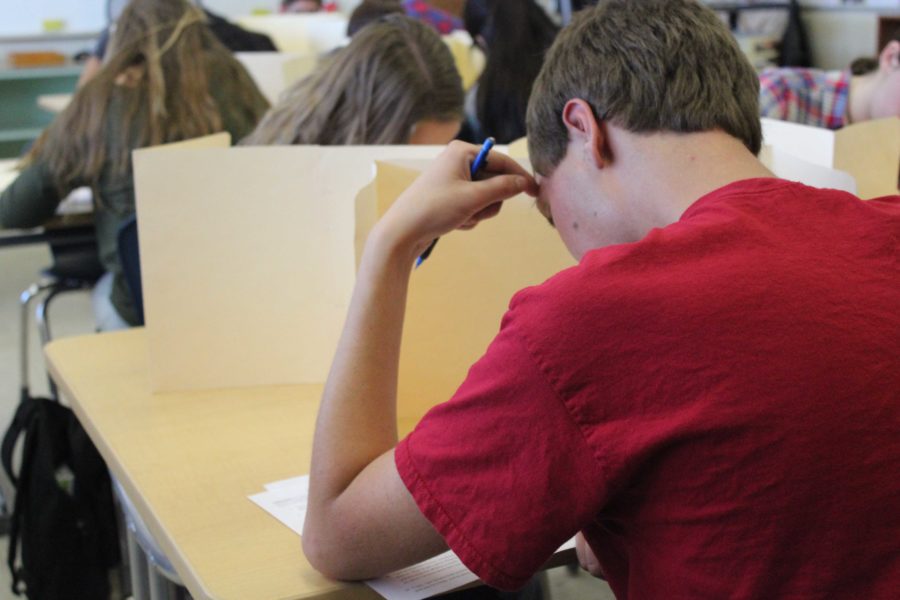An insight into AP
Mr. Falconer’s AP Language and Composition class takes a practice test to prepare for the upcoming exam in May.
Junior Hannah Kwon spends three to four hours a day studying for her four AP (Advanced Placement) courses–AP Psychology, AP Chemistry, AP Language and Composition, and AP U.S. History–whereas her other classes receive only thirty minutes of her attention collectively.
Similar stories ring true for the 633 other AP students at Cam High. By taking AP courses, students often subject themselves to additional stress, homework, and monetary expense. So, why do AP courses remain so popular?
What is AP?
AP classes aim to challenge students with a faster-paced curriculum and give students the opportunity to test out of introductory-level college courses. Students who score a grade of 3 or higher (on a 5-point scale) on an AP exam are eligible for college credit at some universities. This year, 1443 exams were sold to students.
Cam High offers around 20 AP classes, ranging from AP Human Geography to AP English Language and Composition. The exact class count depends on the level of student demand and number of teachers willing to teach AP.
“They’re rigorous courses, but as long as you are able to manage your time well and prioritize, you should be able to get by,” said Kwon.
AP classes are graded on a five point scale instead of the standard college prep (CP) four-point scale, meaning an A in an AP class is counted as five GPA points instead of four.
The Benefits of AP
Despite the difficulty level of AP classes, many students say taking the classes are worth the effort. “I think to myself almost everyday in AP Chemistry, ‘I want to drop,'” said Kwon. “But I know once I get through it, it’ll be worth it. The knowledge that I got through a hard course and the knowledge that I’m capable of doing well in a tough academic setting is empowering.”
“In an AP environment, students should expect a college-like setting, active participation, active reading, and essay writing for history,” said Mrs. Tawney Safran, fourth year AP European History teacher. “Hopefully, they’re mature and responsible. They will build an array of strategies and skills.”
Teachers at Cam High who teach both AP and CP (College Preparatory) or Honors classes said that the teaching styles and classroom atmospheres vary greatly. AP U.S. History teacher, Mr. Matthew Doyle, said students should expect a heightened level of discussion and understanding from AP courses. “APs offer more higher-level thinking type of questions, not so much just telling me what happened [during a historical event], but why, what influenced it, what caused it, what were its effects,” he said.
Safran strives to allow her students to express themselves and their opinions in an open environment. “Giving the students a chance to feel free to express themselves, creativity, really invoking the nuances, the chance to be heard, and to figure things out are important for a teacher to offer in the AP environment,” she said.
AP courses can also aid students in discovering their passions and potential future career paths. “AP Calculus has changed my way of thinking about the future. I’m going to major in engineering, and the class made me think about how I’m going to use mathematics in college and in a job that I might have,” said Maura Patterson, senior.
“I don’t know what I want to do in the future, so getting a taste of all the subjects is something that I push myself to do, so I can decide what I want to do with my life,” said Avinash Nandakumar, junior who is taking five AP classes.
Passing AP test scores can also shave off credits for college, saving students time and money. “I recommend taking AP because I’m going to start as a sophomore when I go to college. They’re an opportunity to earn a lot of college credit and save some money,” senior Brendon Guizar.
Former Cam High student Michael Huber, now a freshman in college, was able to transfer most of his AP classes into elective credits. “Anything that didn’t directly apply to finishing a GE (General Education) turned into free elective credits,” he said. “Taking AP classes is a lot more useful than the basic CP ones, mostly because the teachers challenge you more.”
Drawbacks of AP
The time commitment often associated with AP classes, however, can leave a student with little time for much else, without firm scheduling.
Sophomore Jacqueline Le has to balance two AP classes with a sport and urges future AP students to delegate their time wisely. “You just have to set your priorities straight. Definitely maintain a balance between your social life and work.”
Mikka Vapor, junior, is taking four AP courses this year, in addition to involvement with work and clubs. “In order to succeed in an AP class, I think you have to stop procrastinating, and I know that’s really hard, but if I get home and do my homework right away, then I have more time to do what I want to do,” she said.
AP tests can also cost a pretty penny. This year, exams were sold for $98 per test. Ninety-five out of 634 students were eligible for a waiver that reduced the cost to $5 per test.
“The biggest thing that differentiates AP classes from other classes is that you have a test in May for APs,” said Guizar.”You’re doing a lot more studying and a lot more work in less time than in other classes.”
Occasionally students drop one or more of their AP classes, often because of the stress or difficulty of the course. Senior Holly Park was taking five AP classes first semester but dropped her AP Physics class second semester. “Right when second semester started, Crowell [the physics teacher] started a new lesson. I tried to keep up and studied way more than I should have, but my other grades were dropping so I was forced to make a decision,” Park said.

Senioritis is real people, but I promise to do my best to overcome and be productive for the good of our beautiful website. I hope you enjoy our publication...

Hey yo, it's Aimee. I'm a Senior. Second year stinger staff writer and social media editor. I still keep up with the Kardashians. I like art, sports, and...

















































































![Senior Ditch Day... Relaxation or Truancy? [Video]](https://achsstinger.com/wp-content/uploads/2017/10/IMG_7119-900x599.jpg)
![Heavy Rain Hits Cam High [video]](https://achsstinger.com/wp-content/uploads/2017/02/maxresdefault-900x506.jpg)




Isa • May 5, 2016 at 1:38 am
Nice work. Great tips on how to prepare for your AP exams.
Alexander Li • Apr 19, 2016 at 9:45 pm
Another drawback of AP is that most colleges don’t even accept AP credit anymore. Even the score of 5 doesn’t get you credit in the UC system in hardcore majors like biology. In community college, on top of that $95 you had to pay for the test, you still have to pay $45 per credit for the test to count toward your degree (though, those credits may be the safety net that helps you graduate/transfer on time).
For the me, it’s not about the college credit or the application but the rigor of the class. You just don’t find that anymore in ordinary high school classes.
Sabrina Y • Apr 8, 2016 at 3:32 pm
Hi!
Not really relevant to this article, but can Stinger do an article about seniors that got accepted to their no. 1 schools and/or those that got accepted to all schools applied? With their tips to-do and not to-do. This will be very helpful to freshmen, sophomore, and juniors when we apply for college. It’s getting tough to get into UCs, the insights of those – ‘been there/done that’ are valuable.
Thanks!